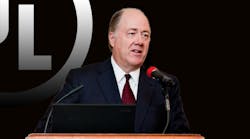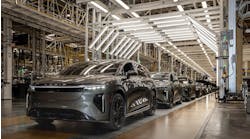At the giant Hannover Messe industrial fair in Hannover, Germany, UL, the venerable safety certification firm founded in 1894, occupies a rather modest booth. But make no mistake, UL is a global player with a large and growing range of services to offer its clients in 113 countries. This expansion is just part of a series of changes at UL designed to make the company more customer-focused and able to meet clients’ needs across an array of new technological challenges.
In 2007, UL began a new practice that has had a major impact on its employees and operations. After each project, the company sent the customer a questionnaire. One of the questions asked how likely the customer would be to recommend UL to another firm.
“When we started, we were probably below the industry BtoB worst in class. We were horrible, which we knew,” recalls Keith Williams, the president and CEO of UL since 2005, “but you have to establish a benchmark.”
While UL enjoyed a stellar reputation among consumers who depended on its electrical products testing, Williams, who had spent his career at GE Healthcare and Medtronics, found a company with growing competition but a culture that could be “unresponsive to clients.” And as Williams noted in an interview at Hannover Messe, “That more than anything was the impetus for a change in culture, to realize that if we want to be a successful company, we have to have happy clients.”
While Williams cautions that the company’s cultural change is far from over, after nine years the company now rates between average and best in class in customer surveys. “Every quarter we get a score from customers on how we did,” said Williams. “People like to see that we did better, that our customers are happier. It has been a nice trend upward.”
Williams credits the “tremendous progress” largely to a consistent investment in employee training and executive leadership development. “I really see training as the only dial you have as a CEO to change culture,” he says. UL spends 2% of its revenue on training for its nearly 11,000 employees, with about two-thirds of that devoted to technical training.
UL gets feedback on about 20% of the surveys it sends out. Not only does the rising score serve as a motivator for employees, but customers frequently provide comments, of which Williams says the company makes good use
Acquisitions Target Growth Areas
A greater focus on customers is just one of the sweeping changes that has occurred at UL during Williams’ tenure. The company has spent more than $1 billion on about three dozen acquisitions to broaden the scope of its customer services.
“We have always been known for testing, inspection and certification for safety but today clients need many more services,” says Williams. The portfolio of services UL now offers range from testing consumer goods such as furniture and shoes to auditing social accountability in factories to electronic payment security. The company has also increased its presence in software, with products such as workplace safety and health training, occupational and environmental health programs, and materials sourcing. In Germany, Williams noted, UL acquired DEWI, a firm that offers wind energy services such as testing of turbine components and analyzing sites for wind farms. UL’s income from software as a service is $100 million annually.
There is no lack of new challenges for UL to take on. Eighteen months ago, the company formed a small team to examine the rise of additive manufacturing and how it would affect the products that UL tests. To better understand the technology, UL formed a partnership with the University of Louisville and built an additive manufacturing training center. A similar center was created later in Singapore.
“It is simply teaching people about additive manufacturing and in the process we are learning,” Williams observes, saying that while UL’s role is still uncertain, it is clear that “we are going to see more and more products made through additive manufacturing.”
One additive manufacturing issue that UL is exploring is the impact of the process on indoor air quality in the workplace and the home. “You’re melting plastic, so you’re obviously going to get some emissions,” Williams observed, adding that UL offers a broad array of testing on products such as building materials for their impact on indoor environments.
In February, UL announced that it would begin testing hoverboards for potential electrical and fire hazards related to their electric drive train, including the rechargeable battery and the charger system. UL will test and certify the controversial devices using a newly issued UL 2272 standard. UL was helped in this effort by several years of research on battery safety at labs such as its Taipei, Taiwan facility. That research has also resulted in UL conducting a series of seminars around the world on how lithium ion batteries can be safely transported in airplanes.
UL also has plunged into the area of cybersecurity. At the Hannover show, UL announced a new Cybersecurity Assurance Program (UL CAP) which uses the UL 2900 series of standards in order to test network-connectable products and systems for security vulnerabilities. UL cited studies by Gartner and others that there will be 21-50 billion connected devices by 2020, and that by 2018, 66% of networks are expected to suffer an IoT security breach. Rachna Stegall, UL’s director of Connected Technologies, said the company aimed to “help manufacturers, purchasers and end-users, both public and private, mitigate those risks via methodical risk assessments and evaluations.”
A Bullish Outlook on U.S. Manufacturing
Given his long association with manufacturing and UL’s deep involvement with product standards and testing, Williams was asked how he viewed the state of U.S. manufacturing.
“Manufacturing for every country in the world is always going to be in flux,” Williams observed, pointing out how television production migrated from the U.S. to Japan and then China. He said this development of new manufacturing centers was good because it led to global economic growth and promoted peace.
Williams continued that he was “very bullish’ on U.S. manufacturing, citing as major assets the strong innovation performance of its companies and its financial and legal system. He added that he expects advanced manufacturing to bring some operations back to the U.S. Advanced manufacturing requires that the U.S. invest in education, vocational training and re-education of some workers, he said, in order to develop the workforce needed for these more skilled factory jobs.
He said innovation will allow the country to continually make new products while shedding some existing industries such as low-cost clothing manufacturing. He noted, “What is important for us is to figure out how to benefit from the change rather than be hurt by it.”




